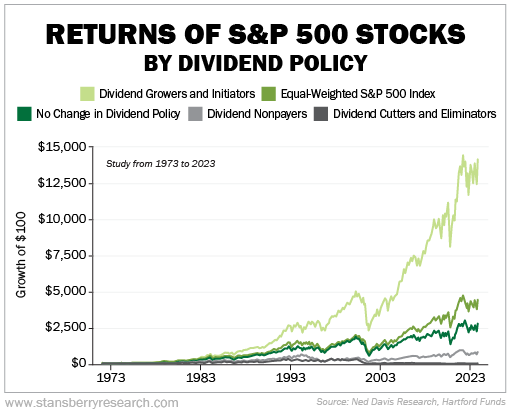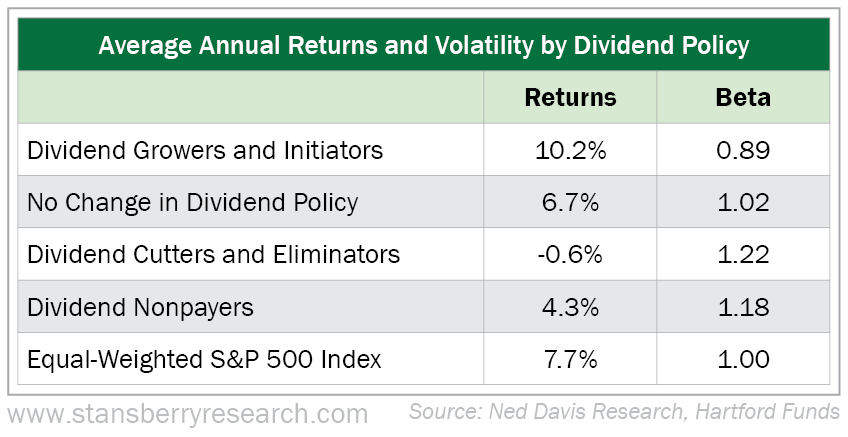I figured out the trick to successful investing early on...
While my Wall Street peers chased the next big winner from exciting but unpredictable investments, I always preferred solid stocks that paid attractive dividends. These cash payments were a safe and steady stream of income.
Money in my pocket always meant more to me than a potential triple-digit winner that required things to work out perfectly.
Today, most investors don't care that much about dividends. Take market darling Nvidia, for example... It recently hit a new all-time high despite paying a measly dividend yield of 0.03%.
But from decades of firsthand experience studying the markets, I've found that consistent and safe income is key to any successful long-term retirement account.
The chart below shows the benchmark S&P 500 Index's return each decade since the 1930s. Over a span of 90 years, dividends were responsible for roughly 40% of the total market return. Take a look...

Remember, dividends compound your capital. Every quarter, you have more money to invest than before. This lets your gains multiply over the long term.
Now, income investing isn't as easy as it seems.
It makes sense to assume that stocks with the highest dividend yields would have the best historical returns. After all, the higher the yield, the more cash you take in each quarter. And isn't a generous yield a sign of a cash-gushing business?
Well, not always.
A stock's dividend yield is calculated by taking the annual per-share dividend payment and dividing it by the stock price. So if a stock has been tanking, its dividend yield is going to increase even if its payments don't.
Also, you have to be wary of a stock's "dividend payout ratio." You don't want to see a company paying more toward its dividend than it generates in earnings. This is never a healthy dynamic. Even though the yield may be attractive, the most likely outcome in this scenario is an eventual dividend cut.
Income investors need to focus on more than just big yields. Rather, they need to consider how consistently a company grows its dividend.
The S&P 500 Dividend Aristocrats Index – which comprises companies that have grown their dividends for at least 25 consecutive years – has averaged 10.5% annual returns since 2008.
The Dow Jones U.S. Select Dividend Index – which comprises the top stocks by dividend yield – has averaged just less than 9% annual returns.
Clearly, owning dividend growers is the smart move.
This is why my team and I always look for companies with management teams that are committed to growing dividends – over many years and through various economic cycles.
And a study by Ned Davis Research further supports this strategy...
In it, researchers broke S&P 500 companies up into four groups... dividend growers and initiators, companies that had no change in their dividend policy over the last 12 months of the study, companies that cut or got rid of their dividends, and companies that paid no dividend at all.
If you started out in 1973 with $100, the dividend growers performed the best, even beating the broader equal-weight index...

The dividend-growers cohort also had the lowest "beta." In stock market parlance, beta measures the correlation of an individual stock to the market as a whole. A beta of 1.0 means the stock's price moves in tandem with the market... If the market is up 5%, the stock is up 5%.
A beta of more than 1.0 means the stock's price is more volatile than the market (with more pronounced rises and falls). And a beta of less than 1.0 means the stock's price is less volatile than the market.
The goal of any investor should be to own stocks with a beta of less than 1.0. This is especially true for folks nearing or in retirement, as less volatility is ideal.
And that's yet another reason why dividend growers are so attractive. Take a look...

Putting it all together, you can see why I love dividend-growing companies so much... They offer a reliable flow of income, return 10.2% a year on average, and are less volatile than the overall market.
Given today's macroeconomic outlook, consistent dividend growth is now more crucial than ever...
The market is facing a lot of trouble. And investors who aren't prepared could see their retirement accounts wiped out.
In a new presentation, I outline my safe and proven strategy for making big gains... without all the unnecessary risk. (And yes, part of this strategy involves dividend-paying stocks.)
What We're Reading...
- Something different: Al Pacino says "it's fun" to be a new dad at age 84.
Here's to our health, wealth, and a great retirement,
Dr. David Eifrig and the Health & Wealth Bulletin Research Team
October 16, 2024
